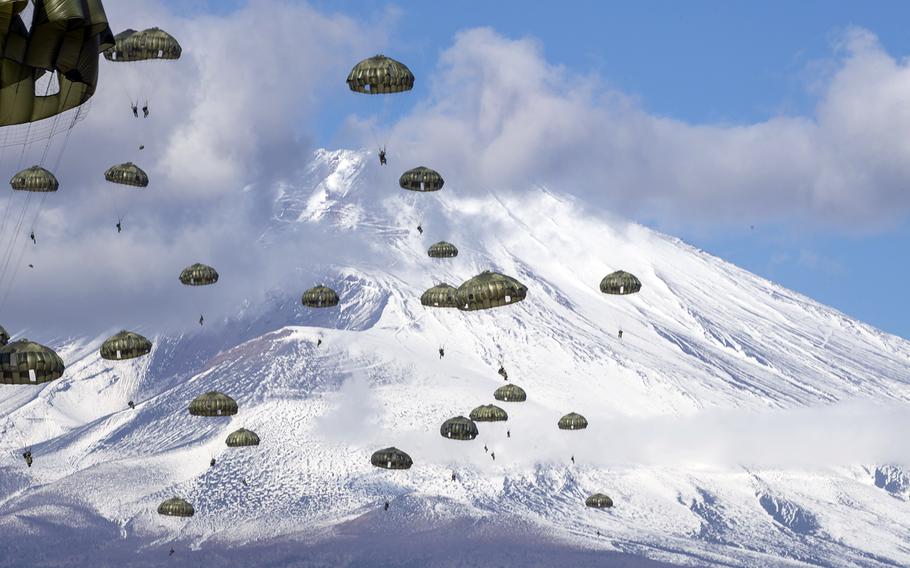Air Force
US, Japanese troops practice jumps and airdrops in Mount Fuji’s foothills
Stars and Stripes February 1, 2023

Japan Ground Self-Defense Force paratroopers assigned to the 1st Airborne Brigade descend from an Air Force C-130J Super Hercules over the East Fuji Maneuver Area, Japan, Tuesday, Jan. 31, 2023. (Yasuo Osakabe/U.S. Air Force)
YOKOTA AIR BASE, Japan — U.S. airmen and Japanese soldiers gathered recently at this airlift hub in western Tokyo to stuff sand, rocks and water into wooden crates ahead of an annual jump by hundreds of airborne troops from both nations.
A week before the jumps on Tuesday and Wednesday, the U.S. and Japanese troops met in a logistics warehouse at Yokota, home of the 374th Airlift Wing. There, they filled the boxes to simulate supply bundles of 501 to 2,200 pounds, Airman 1st Class Izaiah Dillion, combat mobility operations technician for 374th Logistics Readiness Squadron Combat Mobility Flight, told Stars and Stripes on Wednesday.
The airdrop and airborne jump is an annual event, but the 100 bundles were assembled for the first time in the logistics squadron’s warehouse. Squadron airmen were joined by members of the Japan Ground Self-Defense Force.
“It strengthens our relationships with our Japanese forces,” said Tech. Sgt. Cassandra Benson, a section chief with the squadron.
“We also teach each other things,” said Benson, 38, of Waverly, Tenn. “When we work with other countries like this, we just get to see how they do things. They might have a better idea; if they do, we can adapt and make it better.”
The annual exercise, dubbed Airborne 2023, brings more than 500 Japanese and U.S. troops together to train as one force. They filed onto nine Air Force C-130J Super Hercules airlifters each day for the 45-minute flight to Higashifuji Training Field in the Mount Fuji foothills, where the cargo bundles and the paratroopers were dropped together.
“The goal is to practice our interoperability with the JGSDF and work on our partnership with our partner and allied nation,” Capt. Jeffry Lewoczko, a Super Hercules pilot with the 36th Airlift Squadron and mission commander for Airborne 2023, told Stars and Stripes on Tuesday.
The U.S. military often uses “interoperability” to describe the ability of a country’s armed forces to use another’s training methods and military equipment.
The exercise came two weeks after the U.S. secretaries of defense and state met their Japanese counterparts in Washington, D.C., where they pledged deeper military cooperation in the face of increasing security threats from China and North Korea.
Defense Secretary Lloyd Austin said the enhanced agreements reflect the "ironclad commitment" by the United States to defend Japan with all its capabilities, including nuclear weapons, and counter China’s “destabilizing actions” in the region.
Taking part in the exercise this week were Japan’s 1st Airborne Brigade, the Air Force 36th Airlift Squadron, 374th Maintenance Group, 374th Logistics Readiness Squadron Combat Mobility Flight and 374th Operations Support Squadron from Yokota and the 327th Airlift Squadron from Little Rock Air Force Base, Ark.
Lewoczko, of Medina, Tenn., said Airborne 2023 for him is a special event because it was his first exercise at Yokota. He piloted a Super Hercules in formation during last year’s drop.
“It's a lot of work but very rewarding,” he said. “Getting to work closely with our partners in the JGSDF is exceptionally educating for me, getting to see how they approached their planning process and being able to fully integrate that with the US planning process it’s very important.”